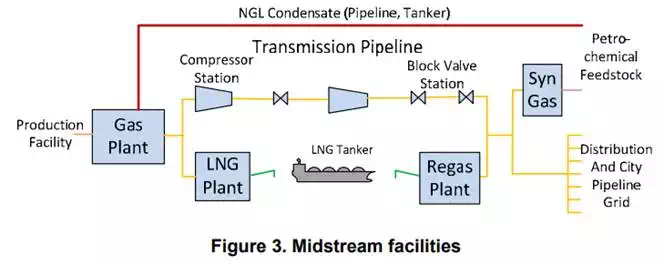Upstream process sections
We will go through each section in detail in the following chapters. The summary below is an introductory synopsis of each section. The activities up to the producing wellhead (drilling, casing, completion, wellhead) are often called “pre-completion,” while the production facility is “post-completion.” For conventional fields, they tend to be roughly the same in initial capital expenditure.
Wellheads
The wellhead sits on top of the actual oil or gas well leading down to the reservoir. A wellhead may also be an injection well, used to inject water or gas back into the reservoir to maintain pressure and levels to maximize production. Once a natural gas or oil well is drilled and it has been verified that commercially viable quantities of natural gas are present for extraction, the well must be “completed” to allow petroleum or natural gas to flow out of the formation and up to the surface. This process includes strengthening the well hole with casing, evaluating the pressure and temperature of the formation, and installing the proper equipment to ensure an efficient flow of natural gas from the well. The well flow is controlled with a choke.

We differentiate between, dry completion (which is either onshore or on the deck of an offshore structure) and subsea completions below the surface. The wellhead structure, often called a Christmas tree, must allow for a number of operations relating to production and well workover. Well workover refers to various technologies for maintaining the well and improving its production capacity.
Manifolds and gathering
Onshore, the individual well streams are brought into the main production facilities over a network of gathering pipelines and manifold systems. The purpose of these pipelines is to allow setup of production "well sets" so that for a given production level, the best reservoir utilization well flow composition (gas, oil, water), etc., can be selected from the available wells.
For gas gathering systems, it is common to meter the individual gathering lines into the manifold as shown in this picture. For multiphase flows (combination of gas, oil and water), the high cost of multiphase flow meters often leads to the use of software flow rate estimators that use well test data to calculate actual flow.

Offshore, the dry completion wells on the main field center feed directly into production manifolds, while outlying wellhead towers and subsea installations feed via multiphase pipelines back to the production risers. Risers are a system that allows a pipeline to "rise" up to the topside structure. For floating structures, this involves a way to take up weight and movement. For heavy crude and in Arctic areas, diluents and heating may be needed to reduce viscosity and allow flow.
Separation
Some wells have pure gas production which can be taken directly for gas treatment and/or compression. More often, the well produces a combination of gas, oil and water, with various contaminants that must be separated and processed. The production separators come in many forms and designs, with the classic variant being the gravity separator.

In gravity separation, the well flow is fed into a horizontal vessel. The retention period is typically five minutes, allowing gas to bubble out, water to settle at the bottom and oil to be taken out in the middle. The pressure is often reduced in several stages (high pressure separator, low pressure separator, etc.) to allow controlled separation of volatile components. A sudden pressure reduction might allow flash vaporization leading to instability and safety hazards.
Metering, storage and export
Most plants do not allow local gas storage, but oil is often stored before loading on a vessel, such as a shuttle tanker taking oil to a larger tanker terminal, or direct to a crude carrier. Offshore production facilities without a direct pipeline connection generally rely on crude storage in the base or hull, allowing a shuttle tanker to offload about once a week. A larger production complex generally has an associated tank farm terminal allowing the storage of different grades of crude to take up changes in demand, delays in transport, etc. Metering stations allow operators to monitor and manage the natural gas and oil exported from the production installation. These employ specialized meters to measure the natural gas or oil as it flows through the pipeline, without impeding its movement.

This metered volume represents a transfer of ownership from a producer to a customer (or another division within the company), and is called custody transfer metering. It forms the basis for invoicing the sold product and also for production taxes and revenue sharing between partners. Accuracy requirements are often set by governmental authorities.

Typically, a metering installation consists of a number of meter runs so that one meter will not have to handle the full capacity range, and associated prover loops so that the meter accuracy can be tested and calibrated at regular intervals.
Utility systems
Utility systems are systems which do not handle the hydrocarbon process flow, but provide some service to the main process safety or residents. Depending on the location of the installation, many such functions may be available from nearby infrastructure, such as electricity. Many remote installations are fully self-sustaining and must generate their own power, water, etc.
Midstream
The midstream part of the value chain is often defined as gas plants, LNG production and regasification, and oil and gas pipeline transport systems.
